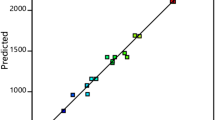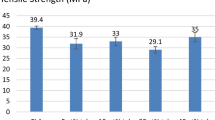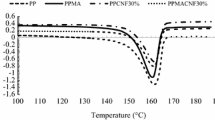In this study, the degradation of mechanical properties of polypropylene(PP)/talc composite after immersion in benzene was evaluated experimentally. Tensile tests were performed before and after immersion in benzene on specimens of this micro-composite, with different talc weight contents (0, 10, 40, and 50%). Microscopic observations were also performed on immersed and non-immersed specimens to explain the results of the tensile tests. These results show that the presence of talc particles improved the rigidity of the composite by increasing its Young modulus and decreasing its ultimate strain. However, the immersion in benzene caused significant degradation of the Young modulus, even though the talc content was increased. The study was completed by determining the optimal values of talc conten using the design experiment method.
















Similar content being viewed by others
References
A. A. El-Midany and S. S. Ibrahim, “The effect of mineral surface nature on the mechanical properties of mineral-filled polypropylene composites”, Polym. Bull., 64, 387–399 (2010).
J. Chen, Y. Yan, T. Sun, et al., “Probing the roles of polymeric separators in lithium-ion battery capacity fade at elevated temperatures”, J. Electrochem. Soc., 161, No. 9, 1241–1246 (2014).
S. Yan, X. Xiao, X. Huang, et al., “Unveiling the environment-dependent mechanical properties of porous polypropylene separators”, Polymer, 55, No. 24, 6282–6292 (2014).
F. Iñiguez-Franco, R. Auras, G. Burgess, et al., “Concurrent solvent induced crystallization and hydrolytic degradation of PLA by water-ethanol solutions”, Polymer, 99, 315–323 (2016).
S. A. Jabarin and W. J. Kollen, “Polyolefin properties for rigid food packaging”, Polym. Eng. Sci., 28, 1156–1161 (1988).
B. Abbes, O. Zaki, and L. Safa, “Experimental and numerical study of the aging effects of sorption conditions on the mechanical behaviour of polypropylene bottles under columnar crush conditions”, Polym. Test., 29, 902–909 (2010).
X. Niu, E. Martynenko, A. Chudnovsky, et al., “The effect of chemical degradation on physical properties and fracture behavior of poly (ethylene-co-carbon) and poly(1-butene)”, in: Proc. of ANTEC 2000 III, Orlando, Florida (2000), pp. 3228–3232.
R. van Dijk, J. C. Sterk, D. Sgorbani, and F. van Keulen, “Lateral deformation of plastic bottles: Experiments, simulations, and prevention”, Packag. Technol. Sci., 11, 91–117 (1998).
I. Widiastuti, I. Sbarski, and S. H. Masood, “Mechanical response of poly (lactic acid)-based packaging under liquid exposure”, J. Appl. Polym. Sci., 131, 40600 (2014).
I. Widiastuti, I. Sbarski, and S. H. Masood, “Sorption characteristic of organic liquid and its effect on the mechanical performance of a PLA-based plastic”, J. Appl. Polym. Sci., 133, 43250 (2016).
https://www.calpaclab.com/polypropylene-chemical-compatibility-chart/
H. Essabir, M. O. Bensalah, D. Rodrigue, et al., “A comparison between bio- and mineral calcium carbonate on the properties of polypropylene composites”, Constr. Build. Mater., 134, 549–555 (2017).
S. Ikram, O. Das, and D. Bhattacharyya, “A parametric study of mechanical and flammability properties of biochar reinforced polypropylene composites”, Compos. Part A-Appl. S., 91, 177–188 (2016).
F. A. Ghasemi, I. Ghasemi, S. Menbari, et al., “Optimization of mechanical properties of polypropylene/talc/graphene composites using response surface methodology”, Polym. Test., 63, 283–292 (2016).
M. A. Gafur, R. Nasrin, M. F. Mina, et al., “Structures and properties of the compression-molded istactic-polypropylene/talc composites: Effect of cooling and rolling”, Polym. Degrad. Stabil., 95, 1818–1825 (2010).
A. O. Bouakkaz, A. Albedah, B. B. Bouiadjra, et al., “Effect of temperature on the mechanical properties of polypropylene–talc composites”, J. Thermoplast. Compos., 31, No. 7, 896–912 (2018).
MODDE 5.0 (Modeling and Design), Umetrics AB, Umeå, Sweden.
L. Eriksson, E. Johansson, N. Kettaneh-Wold, et al., Design of Experiments: Principles and Applications, Umeå Learnways AB, Stockholm (2000).
N. L. Frigon and D. Mathews, Practical Guide to Experimental Design, Wiley, New York (1996).
B. A. B. Bouiadjra, A. Albedah, M. M. Bouziane, et al., “Effects of voids growth on the damage of polypropylene/talc micro-composite”, J. Fail. Anal. Preven., 18, 1111–1119 (2018).
S. A. Reffas, M. Elmeguenni, and M. Benguediab, “Analysis of void growth and coalescence in porous polymer materials”, Technol. Appl. Sci. Res., 3, 452–460 (2013).
Author information
Authors and Affiliations
Corresponding author
Additional information
Translated from Problemy Mitsnosti, No. 3, p. 115, May – June, 2022.
Rights and permissions
Springer Nature or its licensor holds exclusive rights to this article under a publishing agreement with the author(s) or other rightsholder(s); author self-archiving of the accepted manuscript version of this article is solely governed by the terms of such publishing agreement and applicable law.
About this article
Cite this article
Bouiadjra, B.B., Fekih, S.M., Bouziane, M.M. et al. Optimization of the Mechanical Strength of PP/TALC Micro-Composite after Immersion in Benzene. Strength Mater 54, 493–502 (2022). https://doi.org/10.1007/s11223-022-00424-0
Received:
Published:
Issue Date:
DOI: https://doi.org/10.1007/s11223-022-00424-0




